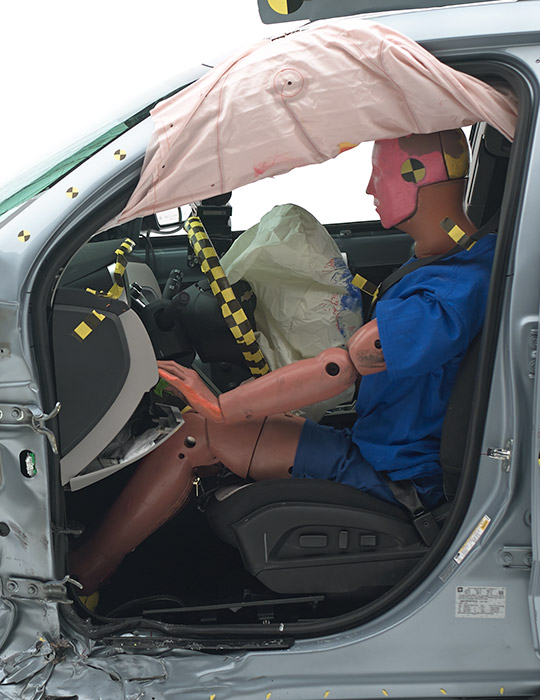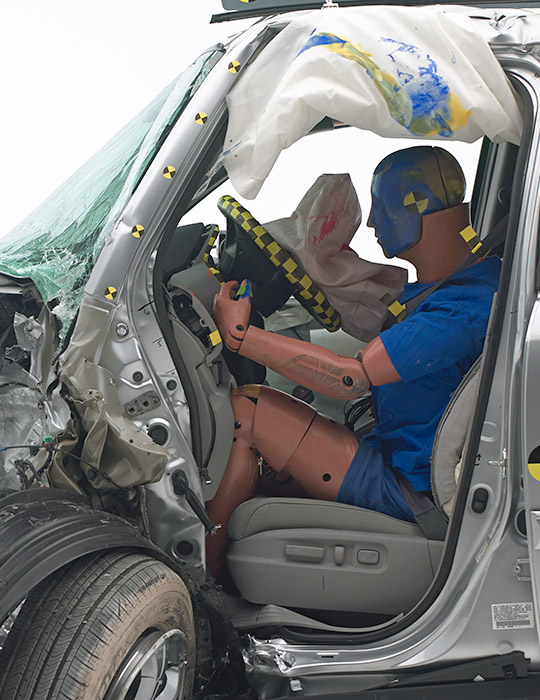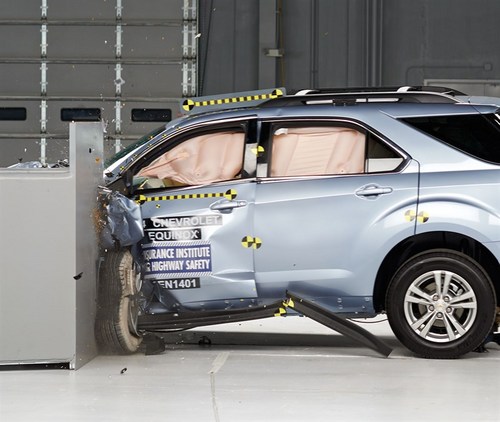IIHS Mid-size SUV Small Overlap Front Crash Test-Only Two of Nine Earn Good Rating - GM Leads The Way +VIDEO
SEE ALSO: Big Family? 6+ Passenger Vehicle Choices
SEE ALSO: Find Your Perfect SUV Match
Arlington, VA April 8, 2014; The IIHS reported that the Chevrolet Equinox and its twin, the GMC Terrain, are the only midsize SUVs out of nine evaluated to earn a good rating in the IIHS small overlap front crash test, which continues to challenge manufacturers more than a year and a half after its introduction.
The Equinox and the Terrain qualify for the Institute's highest award for 2014, TOP SAFETY PICK+. The Toyota Highlander, a midsize SUV whose acceptable small overlap rating was announced in December, also qualifies. The award is given to vehicles with a good or acceptable small overlap rating, good ratings in four other occupant protection tests, and a rating of basic or higher for front crash prevention.
Three other midsize SUVs in the test group rate poor for small overlap protection, and three are marginal.
"SUVs have gotten much safer over the past few generations, but some are better than others at providing comprehensive front crash protection," says David Zuby, IIHS executive vice president and chief research officer. "When it comes to midsize SUVs, General Motors is showing the way forward. The Equinox and Terrain score well in all components of the small overlap test — structure, restraints and kinematics, and injury measures for four body regions."
The small overlap test replicates what happens when the front corner of a vehicle collides with another vehicle or an object such as a tree or utility pole. In the test, 25 percent of a vehicle's front end on the driver's side strikes a rigid barrier at 40 mph.
The test is more difficult than either the head-on crashes conducted by the government or the longstanding IIHS moderate overlap test. In a small overlap test, the main structures of the vehicle's front-end crush zone are bypassed, making it hard for the vehicle to manage crash energy. The occupant compartment can collapse as a result.
The Equinox and Terrain were able to overcome this challenge, thanks to modifications on 2014 models to their front structure and door-hinge pillars. In the test, which was conducted on an Equinox but applies to the Terrain as well, the driver space was well-maintained, and the dummy’s movement was well-controlled. The dummy’s head hit the frontal airbag and stayed there. It would have been a perfect test performance if the side curtain airbag had provided more forward coverage. As it was, there was a gap in the inflated portion, which, in a slightly different crash, could leave the head vulnerable to hitting the door or intruding objects.


Survival space: The structure of the Chevrolet Equinox (left) held up well, leaving adequate space for the driver. In contrast, the driver space in the Honda Pilot was seriously compromised. In the worst instance of intrusion, the parking brake pedal moved inward more than 16 inches.
The Honda Pilot was the worst performer in this group. The driver’s space was seriously compromised by intruding structure. In the worst instance, the parking brake pedal moved inward 16½ inches. The dummy’s head barely contacted the frontal airbag before sliding off the left side, as the steering column moved 5½ inches to the right. Measures taken from the dummy showed injuries to the left hip would be likely in a crash of this severity, and injuries to the left knee and both lower legs would be possible.
A structure that can withstand a crash is the most fundamental aspect of occupant protection. In addition to the Pilot, four other midsize SUVs received a poor rating for structure. One of them, the Mazda CX-9, saw its hinge pillar pushed in 17 inches, bringing the left front wheel even with the dummy’s knee. The side airbag didn’t deploy, and the door frame ended up so far inside the occupant compartment that the dummy’s head struck it after sliding off the frontal airbag. In the Ford Explorer, the door hinge pillar was nearly severed from the door sill.
In five vehicles, the dummy’s head barely contacted the frontal airbag before sliding off it. Only the Equinox/Terrain and the Toyota 4Runner tests showed good engagement with the frontal airbag. In the Jeep Grand Cherokee, the dummy’s head for the most part stayed on the airbag, but too much give in the safety belt allowed the head to move toward the intruding A-pillar.
For the first time in 2014, a good or acceptable rating for small overlap protection, along with good ratings in the moderate overlap front, side, roof strength and head restraint tests, is a requirement for TOP SAFETY PICK. The Equinox, Terrain and Highlander earn the higher accolade of TOP SAFETY PICK+ because each is available with an optional front crash prevention system.
The Highlander earns an advanced rating for front crash prevention. Its system includes both forward collision warning and an automatic braking function that reduced speeds by more than 5 mph in IIHS tests at 12 and 25 mph. The Equinox and the Terrain have warning systems only, and thus earn a basic rating for front crash prevention.
Small overlap front crash test ratings for midsize SUVs
| Dummy injury measures | ||||||||
|---|---|---|---|---|---|---|---|---|
| Overall | Structure | Restraints & kinematics | Head & neck | Chest | Hip & thigh | Lower leg & foot | ||
| Chevrolet Equinox | G | G | G | G | G | G | G | |
| GMC Terrain | G | G | G | G | G | G | G | |
| Toyota Highlander | A | A | A | G | G | G | G | |
| Jeep Grand Cherokee | M | M | A | G | G | G | M | |
| Toyota 4Runner | M | P | G | G | G | G | A | |
| Ford Explorer | M | P | M | G | G | G | A | |
| Kia Sorento | P | P | M | G | G | A | P | |
| Mazda CX-9 | P | P | P | A | G | G | A | |
| Honda Pilot | P | P | M | G | G | P | M | |
| GOOD | G | ACCEPTABLE | A | MARGINAL | M | POOR | P |
The small overlap front crash test stymies most midsize SUVs, with only two out of nine tested — the Chevrolet Equinox and its twin, the GMC Terrain — earning a good rating.
The Insurance Institute for Highway Safety is an independent, nonprofit scientific and educational organization dedicated to reducing the losses — deaths, injuries and property damage — from crashes on the nation’s roads.
The Highway Loss Data Institute shares and supports this mission through scientific studies of insurance data representing the human and economic losses resulting from the ownership and operation of different types of vehicles and by publishing insurance loss results by vehicle make and model.
Both organizations are wholly supported by auto insurers.



